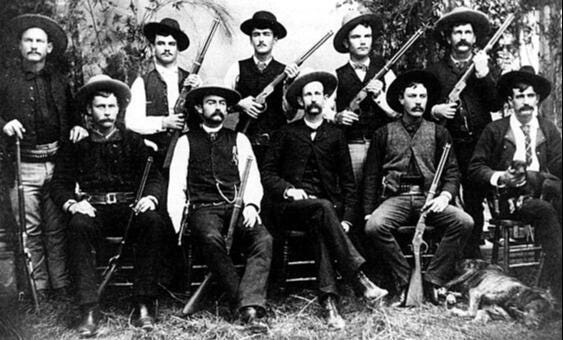Border People: Los Kineños - Hispanic heart of Nation's Largest Ranch
The most important cowboys in Texas history that most have never heard of.

Legends are a fickle thing. Some - like the legends of the Texas Rangers - (the lawmen, not the baseball team) grow and endure. They are celebrated in books and movies and inhabit tales passed from one generation to another.

Others endure but are recounted in whispers - if at all.
Such is the case of Los Kineños - the most important cowboys in Texas history that most have never heard of. It is more likely you've heard of the vast real estate they tamed - The King Ranch - the largest in the United States - occupying about 825,000 acres in South Texas.

The story of the Kineños (Spanish for King's people) begins in 1854 a year after its namesake - Captain Richard King - bought the first tract of land along the only body of water in South Texas between the Rio Grande and the Nueces River 150 miles to the north: The Santa Gertrudis creek.
King needed livestock for the 15,500-acre Spanish Land Grant he purchased (The Rincón de Santa Gertrudis). So he traveled 240 miles south to a ranching community in Northern Mexico (Cruillas, Tamaulipas) suffering from a severe drought. The townspeople were not only willing to agree to sell him their entire herd but for many of them to accompany the cattle back to his ranch in exchange for pledges of food, shelter, and income.

Once on the King Ranch, the former townspeople of Cruillas became known as Los Kineños. The Kineños were already experienced horsemen and cattlemen when they arrived at the King Ranch and their knowledge about tending to a herd in the austere environment of what was then known as El Desierto de los Muertos - the Desert of the Dead - allowed his enterprise to thrive where few others had before.
Among the Kineños were expert cowboys, cooks, weavers of saddle blankets, and leather workers who crafted saddles for the ranch (and whose handiwork is still much sought after today).

I lived in the late 1950s to the early 1980s in Kingsville, Texas - headquarters and namesake of the King Ranch. The ranch and its Kineños were ever-present then, less so now (although their history, businesses, and economic impact still loom large).

A lot of what I took for granted then is gone now: fleets of trucks displaying the ranch brand whose many occupants were conducting business in town - buying provisions for the ranch, working at ranch-owned media enterprises (a newspaper & radio station), a lumberyard, a bank, and a John Deere dealership in a neighboring city. Only the John Deere dealership has survived as part of the King Ranch Corporation. The bank also endures - but it is no longer owned by the ranch family that founded it.

The Kineños and their families were familiar faces and names around town and in my classrooms (despite the fact the ranch operated its own school districts for Kineño children who lived on ranch property).

There was the Maldonado family, related to Beto and Librado Maldonado - "cattle whisperers" who mastered the "showing" of thousand-pound-plus King Ranch livestock from the annual King Ranch auctions in Kingsville to a Chicago television studio to the Dallas–Fort Worth airport. They even boarded a plane with the cattle en route to the International Fair in Casablanca, Morocco, where they introduced the King-Ranch-bred Santa Gertrudis cattle to the African continent.

Or the Villas - whose forebearer Faustino Villa, worked with Captain King on the Rio Grande before following him to the Santa Gertrudis ranch. Villa lived to be 118, and rode horseback until two weeks before his death.

Or the Cavazos family -descendants of the man awarded the original Spanish grant that includes the southern divisions of the King Ranch. One went on to become the foreman of the King Ranch Laureles Division and County Commissioner. Another went on to become President of Texas Tech University & U.S. Secretary of Education under President George H.W. Bush - the first Hispanic to become a cabinet member, despite being a member of President Bush's opposing party (Democrats). A third went on to become a decorated soldier, general, and namesake of Fort Cavazos (formerly Fort Hood).

Or the Muñoz family - who raised a son on the ranch who became the first Hispanic Sheriff of their county as well as the first Hispanic Executive Director of Texas Governor Ann Richards' Criminal Justice Division, and the first Hispanic to serve as Executive director of the Texas Commission on Jail Standards.
I could (and should) go on --- but hopefully, I have conveyed how the Kineños and their families became ingrained in King Ranch and Kingsville lore and the greater community that built up around them.
Where once there used to be hundreds of Kineños tending the cattle - now there are dozens. A helicopter now takes half a day to gather a pasture that once took 30 kineños two days. Many descendants of the original Kineños now live in town instead of on the ranch (though some remain in modest houses there carrying on the kineño tradition as part of a diminished but still important workforce).
For me, the saddest part about their history is how poorly their story was taught in Kingsville schools - and how I have had to learn about their contributions in the years since I left that part of the state. I would like to report that their stories are now part of Texas History curriculums in Texas Primary, Secondary, and University classes --- but sadly I have not seen evidence of that. -Feel free to correct me.
In any case, I hope this story has introduced you to an often-ignored group of people in Texas history who I am proud to call my neighbors and friends.
Abrazos,
Jack Beavers - US Border News



